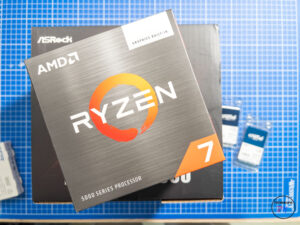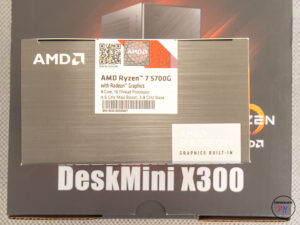The Asrock Deskmini X300 for AMD CPU
I had bought an Asrock Deskmini H470 with an I5-10400 CPU mainly for my home office. This mini PC also met my expectations in terms of speed and power consumption.
Introduction
 As reported, the Deskmini H470 with an i5-10400 CPU and 32 GB RAM needs between 14-16 W in idle. That is already a very good value for a PC with such performance reserves. But now it happened that the Rapsberry Pi, on which I host my Nextcloud for a long time, was no longer sufficient. Especially when displaying pictures or videos the small device had problems.
As reported, the Deskmini H470 with an i5-10400 CPU and 32 GB RAM needs between 14-16 W in idle. That is already a very good value for a PC with such performance reserves. But now it happened that the Rapsberry Pi, on which I host my Nextcloud for a long time, was no longer sufficient. Especially when displaying pictures or videos the small device had problems.
So the idea came up to replace the Rapsberry with such a mini PC. And during the research I found out that the graphics performance of the AMD 5 5600 CPU should be better than the corresponding Intel CPU. So I researched longer, if I should take the X300 with an AMD CPU as a replacement for the Rapsberry Pi.
I recorded a short video about this:
Shopping
 I then went and ordered the Asrock Deskmini X300, also with 32 GB RAM, a WD 750 Blue NVMe SSD. After much deliberation, however, I decided to go with the AMD Ryzen 5 5700G. This is a CPU roughly on the performance class as my already older desktop with the Ryzen 1700X.
I then went and ordered the Asrock Deskmini X300, also with 32 GB RAM, a WD 750 Blue NVMe SSD. After much deliberation, however, I decided to go with the AMD Ryzen 5 5700G. This is a CPU roughly on the performance class as my already older desktop with the Ryzen 1700X.
Now that might be unfair when compared to an Intel i5-10400, but I wanted the extra performance.
Assembly was also very easy. Unlike the H470, the Asrock case comes with a CPU fan and the CPU also comes with a fan. I installed the case’s fan, but I changed that later.
Differences
If you put both systems next to each other, they are practically indistinguishable. The differences are then more in the details.

And the details can be quite relevant. For example, both ports at the front for USB are only designed for USB 3.1 Gen 2, which manifests itself in the transfer speeds.

It does not matter whether you choose the USB-A or USB-C port. The NVMe on the other hand supplies the usual rates for PCI 3.0.

In practice, you can live with the slower rates of the USB front ports. On the back, the X300 case only has one USB-A 2.0 and one USB-A 3.0 port. Besides that, there is still the HDMI and Displayport port. The H470 is much better equipped here.
Performance
If you run a Cinebench R23 test in this combination, this unit naturally comes up with very good scores. This is of course because the AMD 5700G CPU has 8 cores and the base clock is also higher.

In such a scenario, the unit or better the fan gets quite loud because the fan then spins with more than 3,300 rpm. And this is where you realize that the Ryzen 5700G is the more modern CPU after all. In the Cinebench test, it achieved a multi-core score of 13,139 points, while my desktop PC with a Ryzen 1700X only achieved just over 9,000 points. Well, the latter is already almost 6 years old.
But here is perhaps a comparison. If you take 5 different video files (25 min length, 2 1080p, the other 4K) and downsize them with the help of Handbrake, then the desktop PC with the NVidia graphics card manages that in 36:00:93 minutes and here the small Ryzen CPU managed that in the X300 in 36:49:05 minutes. As a comparison, the H470 unit with the I5-10400 still needed 86 minutes here despite the graphics support.
Applications
 Just the almost non-existent difference between the Ryzen 1700X and the model here made me hope that video editing with Da Vince Resolve is possible even with such a small unit without a dedicated graphics card. To cut a long story short, editing 4K clips is possible if you reduce the preview to the 1/2 or even 1/4, for example. I didn’t need to reduce the timeline resolution to 1080p, for example.
Just the almost non-existent difference between the Ryzen 1700X and the model here made me hope that video editing with Da Vince Resolve is possible even with such a small unit without a dedicated graphics card. To cut a long story short, editing 4K clips is possible if you reduce the preview to the 1/2 or even 1/4, for example. I didn’t need to reduce the timeline resolution to 1080p, for example.
You can crop quite well here and even that works without caching. However, exporting the video brings the built-in graphics unit to its limits. Then the export of a 5 minute video in 4K can quickly take 11-13 minutes.
The tool GPU-Z quickly shows load values for the graphics card of 97-98%. And this applies regardless of whether you allocate up to 16 GB of memory to the graphics unit via the BIOS, which is then no longer available to the operating system.
Nevertheless, it works if you only get embarrassed from time to time. However, Lightroom, Photoshop or Affinity are no problem at all for the Mini PC configured this way.
However, I had the problem with Da Vinci that the program reproducibly no longer found a GPU as soon as the graphics drivers were installed.
Conclusion
The X300 in the constellation presented here is more than sufficient for home office (the smaller 5600G CPU would certainly suffice) and even for video editing or image processing there is enough reserve. The only thing that bothers me is that the board is equipped with too few USB ports on the back in contrast to the H470 Intel variant.
ciao tuxoche



